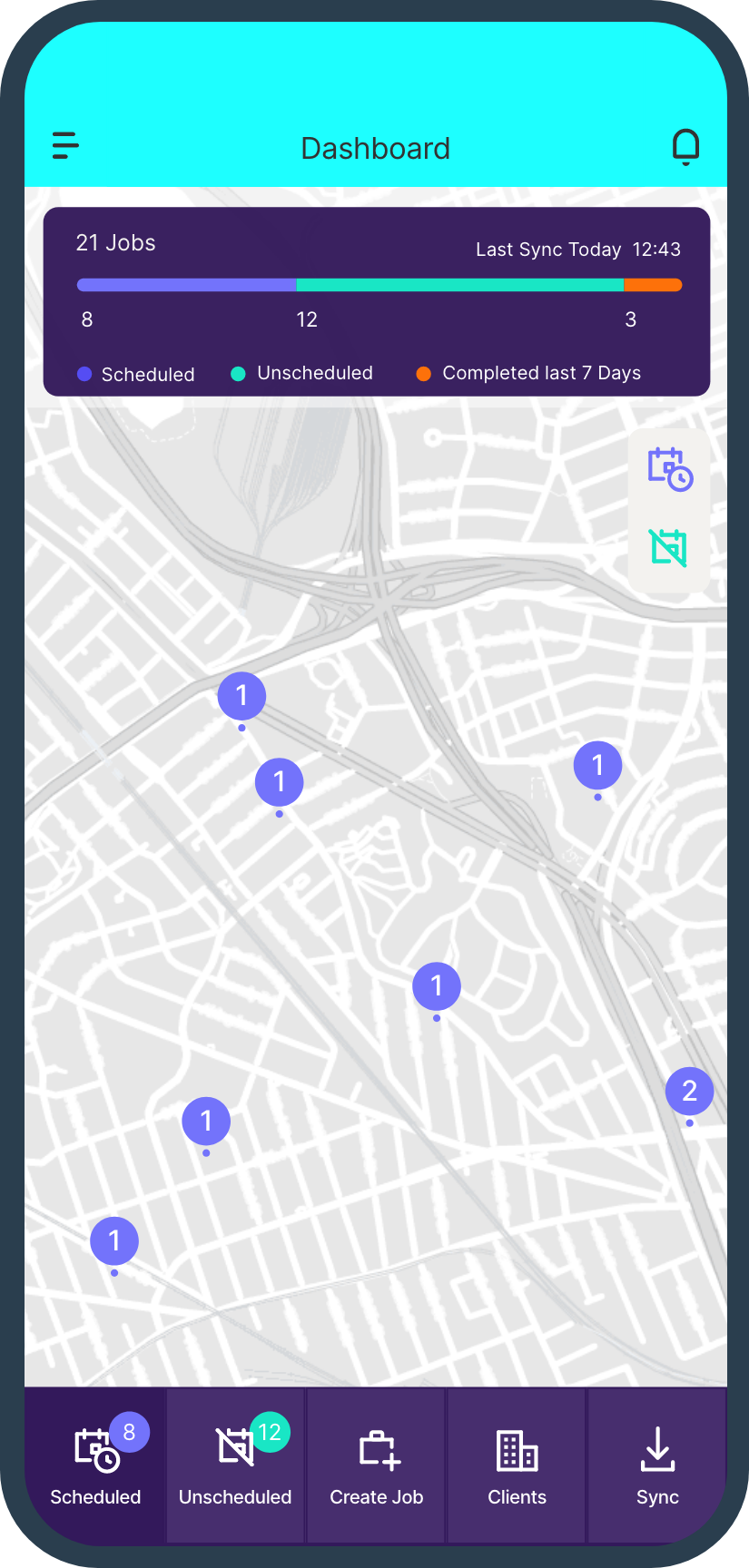If you find yourself clinging to paper scheduling, it’s a clear signal that it’s time to embrace change. Despite the familiarity of this method, sticking to paper is holding your business back. Relying on paper scheduling forces your team to make regular visits to the office to check their assigned jobs or necessitates sending out notifications every time there’s a change in the schedule.
Perhaps you’ve progressed beyond paper schedules and transitioned to using spreadsheets or even a calendar like Outlook or Google. While an improvement over paper, spreadsheets come with their own set of challenges. They remain highly manual, demand a similar level of communication as paper schedules, and lack many features found in modern scheduling apps. Outlook and Google are great calendar applications but they are not designed for scheduling and dispatching your customer jobs with efficiency.
In today’s world, digital scheduling software is the backbone of modern field service businesses. Chances are, you might have already trialled one but with numerous options available, selecting the best scheduling software app for your field service business is crucial. Don’t worry, our guide to picking the right scheduling software has you covered. Let’s delve into the essential features that make scheduling software effective.
The Significance of Scheduling Software in Field Service Management:
Efficient scheduling is the backbone of successful field service management. Whether it’s managing a fleet of technicians, coordinating service appointments, or optimising routes, the right scheduling software can make a significant difference in a business’s overall performance. Some of the key benefits include:
Increased Productivity
Automation of scheduling tasks eliminates the need for manual intervention, allowing teams to focus on more critical aspects of their work. This results in increased productivity and a reduction in the likelihood of errors.
Enhanced Customer Satisfaction
Timely and accurate service appointments lead to improved customer satisfaction. Scheduling software ensures that appointments are made efficiently, minimising wait times for customers and increasing their overall experience.
Cost Reduction
Effective scheduling helps optimise resource allocation, reducing unnecessary travel time and fuel costs. By minimising inefficiencies, businesses can achieve cost savings and improve their bottom line.

What are the qualities you should look for when reviewing Scheduling Software for Field Service?
Selecting the right scheduling software for field service management is crucial for enhancing efficiency, optimising resources, and delivering top-notch customer service. Great scheduling software should encompass a range of features and capabilities that cater to the specific needs of field service businesses. Here are key attributes that make scheduling software stand out in the field service management landscape:
Dynamic Scheduling Capabilities:
- Real-Time Adjustments: Great scheduling software should have the ability to make real-time adjustments to schedules based on factors such as technician availability, location, and urgency of tasks. This dynamic scheduling ensures optimal resource utilisation.
Route Optimisation
- Efficient Route Planning: The software should offer route optimisation features to minimise travel time, reduce fuel costs, and enhance overall operational efficiency. This is particularly important for businesses with a fleet of field technicians.
Calendar Integration
- Seamless Calendar Integration: Integration with calendars ensures that appointments, job assignments, and technician availability are easily accessible in one centralised location. This streamlines communication and coordination across the organization.
Mobile Accessibility
- On-the-Go Access: Mobile accessibility allows field technicians to access their schedules, receive updates, and input data in real-time. A great scheduling software should have a user-friendly mobile interface to facilitate communication and minimize delays.
Automated Notifications
- Proactive Communication: The software should provide automated notifications for upcoming appointments, delays, or any changes to the schedule. This feature enhances transparency, keeps both customers and technicians informed, and reduces the likelihood of misunderstandings.
Work Order Management
- Comprehensive Work Order Features: Efficient work order management capabilities, including creation, assignment, and tracking of work orders, are essential. This ensures that all relevant information is organised and easily accessible.
Scalability
- Adaptability to Business Growth: A great scheduling software should be scalable to accommodate the growing needs of the business. Whether it’s a small business or an enterprise, the software should evolve with the organization.
Integration Capabilities
- Seamless Integration with Other Tools: The software should integrate seamlessly with other essential tools and platforms, such as customer relationship management (CRM) systems, invoicing software, and communication tools. This ensures a cohesive workflow and data flow.
User-Friendly Interface
Implementation of Field Service Scheduling Software Best Practices
Implementing scheduling software effectively requires a strategic approach to ensure a smooth transition and optimal utilisation. Here are some best practices to consider:
Conduct a Needs Assessment
Before selecting a scheduling solution, conduct a thorough needs assessment to identify specific pain points, goals, and requirements. This will guide you in choosing the most suitable software for your business.
Provide Adequate Training
Ensure that all staff members, from office personnel to field technicians, receive comprehensive training on the scheduling software. This will promote efficient usage and minimise disruptions during the implementation phase.
Establish Clear Processes
Define and document clear processes for scheduling, dispatching, and communication. Having well-defined workflows ensures that everyone in the organisation understands their roles and responsibilities within the new system.
Monitor and Evaluate Performance
Regularly monitor the performance of the scheduling software and gather feedback from users. This allows you to identify areas for improvement, address any issues promptly, and continuously optimise your field service management processes.
Stay ahead and embrace Scheduling Software
Scheduling software has become an indispensable tool for field service management, revolutionising the way businesses plan, coordinate, and execute their service operations. The benefits of automation, increased efficiency, and improved customer satisfaction make investing in scheduling software a strategic decision for any field service-oriented business.
By understanding the key features, selecting the right software, and implementing best practices, organisations can unlock the full potential of scheduling software and propel their field service operations to new heights. As technology continues to advance, staying ahead of the curve and embracing innovative solutions will be essential for businesses aiming to thrive in the competitive field service industry.


